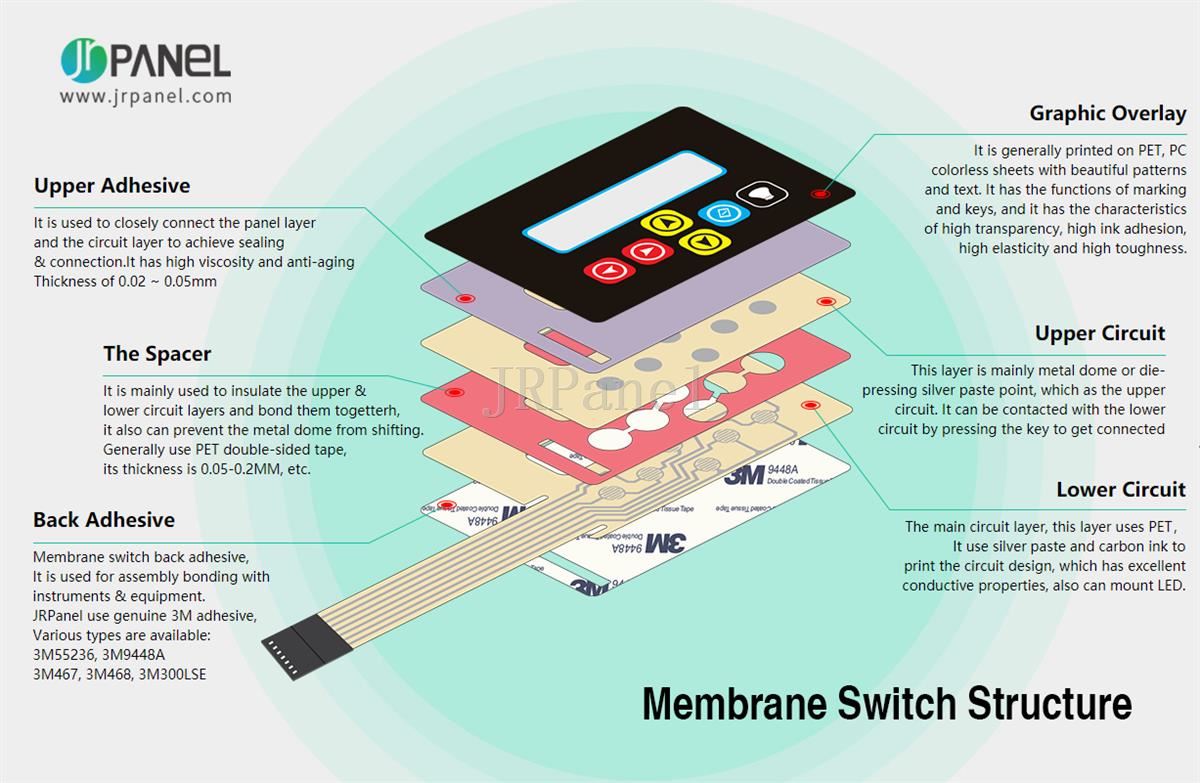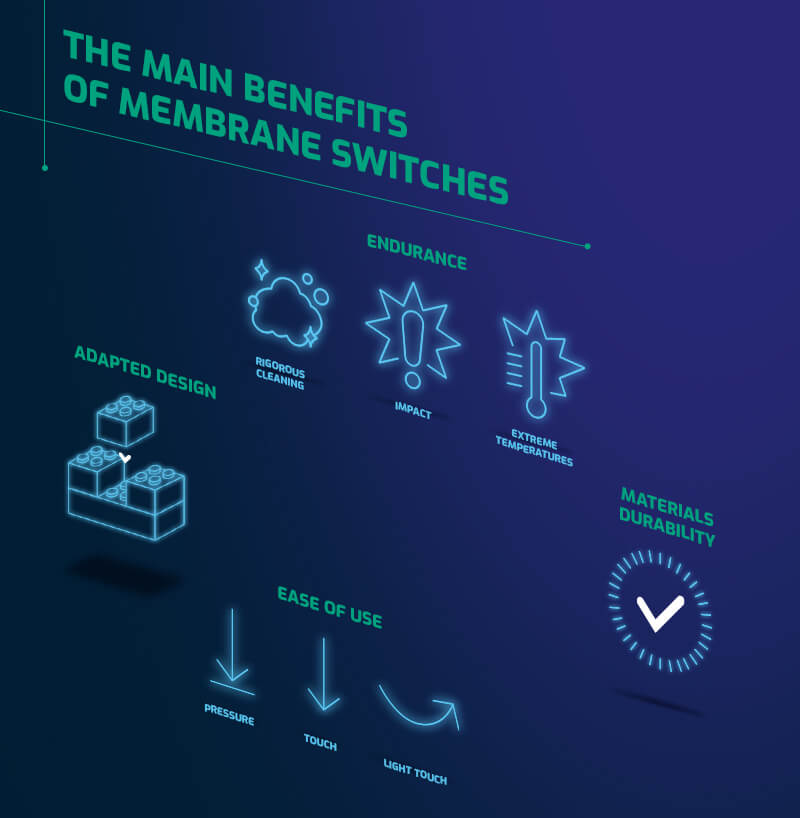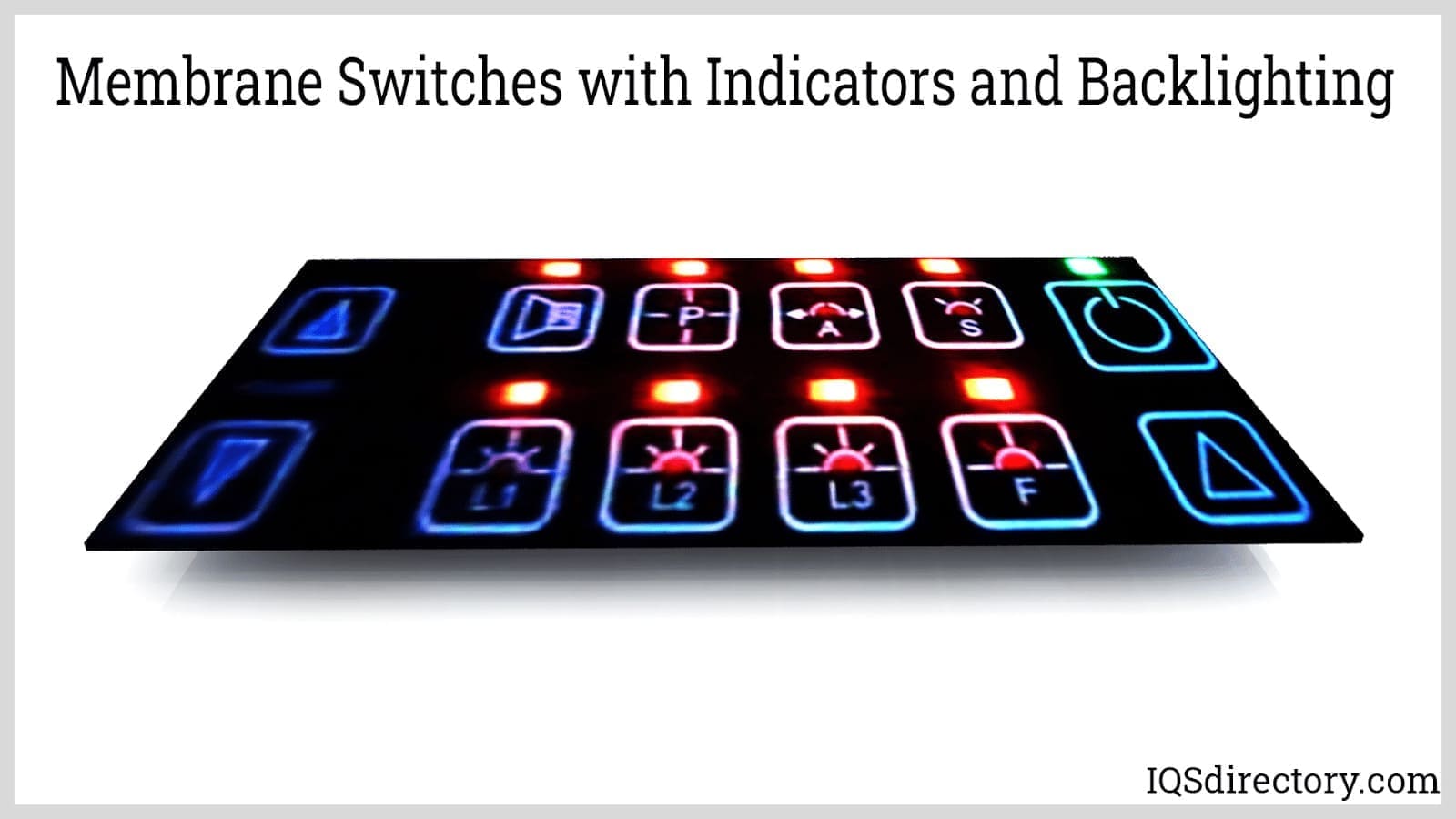Is membrane switch truly withstand harsh industrial environments?
The Production Process Behind Membrane Switch: What You Required to Know
The manufacturing process behind membrane layer changes combines cautious layout, material choice, and quality assurance. It begins with comprehending the intricacies of membrane layer switch style and progresses with various phases, consisting of material selections and printing techniques. Each stage plays a vital function in ensuring performance and durability. The complexities of layer building and the strenuous screening requirements might disclose insights that are not right away noticeable. What lies beyond these foundational components?
Recognizing Membrane Change Layout
Although membrane layer switches may appear basic initially glance, their style includes complex factors to consider that assure functionality and sturdiness. The design process begins with a comprehensive understanding of individual demands, consisting of the user interface's desired application and ecological variables. Ergonomics is a crucial element, as the design needs to assist in simplicity of use while guaranteeing that tactile feedback satisfies customer expectations.Moreover, the layering of parts, such as visuals overlays, sticky layers, and conductive traces, need to be exactly engineered. membrane switch. This split arrangement not just influences the switch's responsiveness but additionally influences its durability. Attention is provided to the sealing techniques used to secure against moisture and dirt, which might jeopardize performance. Furthermore, style considerations extend to looks, where color design and aesthetic clearness enhance customer experience. Inevitably, the design of membrane layer switches over balances capability, user experience, and resilience, making certain that they satisfy the demands of numerous applications efficiently
Materials Utilized in Membrane Layer Switch Over Manufacturing
When picking materials for membrane layer switch production, it is important to ponder both performance and durability. The key materials consist of polyester and polycarbonate films, which supply flexibility and stamina. These movies are frequently covered with adhesive to assure proper bonding to substratums. Conductive inks, typically composed of silver or carbon, are critical for developing electrical links within the button, permitting trusted operation.Additionally, a protective layer, such as a tough layer, is frequently put on improve scrape resistance and longevity. The option of backing product, such as acrylic or foam, can considerably affect the button's responsive feel and total user experience. Different ecological factors, including temperature level and moisture, need to guide material choice to ensure peak efficiency in details applications. Eventually, the appropriate combination of materials adds to the membrane layer button's capability and lifespan, making informed choices vital for suppliers.
The Printing Refine: Creating Video and Text
The printing procedure in membrane layer button production plays a substantial duty in producing top quality graphics and message. Numerous visuals layout strategies are used to assure aesthetic charm and performance, while mindful ink option approaches are essential for durability and performance. Recognizing these components is basic for accomplishing ideal lead to membrane layer switch design.
Graphic Design Techniques
Graphic layout methods play a crucial role in the printing procedure of membrane buttons, as they specify how graphics and message will eventually show up on the end product. Effective visuals style involves the calculated use shades, designs, and typefaces to enhance readability and aesthetic appeal. Developers frequently make use of vector graphics for scalability, making sure that images continue to be sharp at various dimensions. Additionally, interest to comparison and positioning is essential, as it influences individual interaction and visual high quality. The consolidation of branding components, such as logo designs, must be managed with care to maintain brand stability. On the whole, thoughtful graphic design strategies add considerably to the performance and beauty of membrane layer switches, influencing individual experience and product efficiency.
Ink Selection Approaches
Choosing the suitable ink is necessary for accomplishing the desired visual high quality and resilience in membrane layer switch manufacturing. Different ink kinds are utilized, consisting of solvent-based, water-based, and UV-curable inks. Each kind provides distinctive qualities, such as adaptability, attachment, and resistance to environmental variables. Solvent-based inks are usually favored for their durability and dynamic colors, while water-based inks are a lot more eco-friendly but might have limitations in adhesion. UV-curable inks offer fast treating and durable efficiency. In addition, shade matching strategies assure that the picked inks straighten with style requirements. Eventually, the selection of ink need to think about aspects such as application approach, substrate compatibility, and end-use needs to accomplish superior outcomes in membrane switch graphics and message.
Layer Construction and Assembly

Product Option Refine
A cautious choice of materials is crucial in the production procedure of membrane layer switches, as it straight affects performance and sturdiness. The main products used include polyester, polycarbonate, and various conductive inks. Polyester is typically favored for its exceptional resistance to chemicals and abrasion, making it appropriate for harsh settings. Polycarbonate, on the other hand, supplies superior quality and influence resistance, which is beneficial for applications needing visibility and toughness. Conductive inks, generally made up of silver or carbon, are essential for creating dependable electrical pathways. In addition, the option of glue materials affects the overall honesty of the switch - membrane switch. Assessing variables such as environmental direct exposure, responsive feedback, and aesthetic needs overviews producers in selecting the very best products for their particular applications
Layer Attachment Techniques
Adhering layers in membrane layer switch building is a crucial process that assures functionality and long life. Numerous bond strategies are used to secure perfect bonding in between layers, which normally consist of making use of adhesives, warmth, and pressure. Pressure-sensitive adhesives (PSAs) are commonly utilized for their ease of application and prompt bonding capacities. Furthermore, thermal bonding techniques can be used, where warmth is made use of to turn on glue residential properties, safeguarding a solid bond. The option of adhesion approach greatly depends on the materials included and the specific application demands of the membrane button. Correct positioning and consistent application of adhesives are vital to protect against problems, protecting the switch runs successfully throughout its designated life expectancy.
Top Quality Control Actions
Assuring top quality control throughout the layer building and setting up of membrane site here layer buttons is crucial for keeping efficiency and reliability. This process commonly includes a number of critical measures, including comprehensive evaluations at each stage of production. Suppliers use advanced testing techniques, such as peel examinations and bond evaluations, to verify the stability of layer bonds. Additionally, visual inspections are carried out to determine any kind of problems in printing or material inconsistencies. Ecological conditions, such as temperature level and humidity, are carefully monitored to guarantee suitable healing and attachment. Normal calibration of devices helps keep specific manufacturing standards. By applying these quality assurance measures, manufacturers can substantially minimize the risk of product failure, guaranteeing that the final membrane changes meet the required specifications and consumer assumptions.
Testing and Quality Control Steps

Advancements in Membrane Change Technology
As developments in modern technology proceed to evolve, membrane buttons are gaining from innovative advancements that boost their functionality and user experience. One remarkable advancement is the integration of capacitive touch innovation, which enables for even more instinctive and responsive individual interfaces. This shift not only improves looks yet additionally reduces mechanical deterioration, prolonging the life-span of the switches.Additionally, advancements in graphic overlay materials have brought about enhanced longevity and resistance to ecological elements such as moisture and UV light. These materials currently provide enhanced clarity and illumination, more raising the aesthetic appeal.Furthermore, the incorporation of wise technology is transforming membrane changes into interactive control panels, enabling connection with IoT gadgets. This connection cultivates a smooth user experience, paving the means for applications in numerous industries, from medical care to consumer electronic devices. Collectively, these innovations position membrane layer switches as critical elements in modern device style.
Frequently Asked Inquiries
How much time Does the Membrane Layer Switch Production Refine Take?
The duration of the membrane layer switch production process can vary significantly. Variables such as complexity, materials utilized, and production quantity influence timelines, with normal manufacturing ranging from a couple of days to numerous weeks for conclusion.
What Are the Typical Applications for Membrane Layer Buttons?
Membrane switches are commonly made use of in different sectors, including automotive controls, house devices, medical tools, and customer electronic devices (membrane switch). Their convenience and toughness make them optimal for applications requiring straightforward interfaces and reliable performance in diverse atmospheres
Can Membrane Changes Be Custom-made for Certain Demands?

What Is the Life expectancy of a Normal Membrane Layer Switch?
The lifespan of a regular membrane button varies, however normally, it varies from 1 to 5 million cycles. Factors such as usage, setting, and worldly quality considerably influence longevity and overall efficiency with time.

Are Membrane Layer Switches Over Environmentally Friendly?
The ecological friendliness of membrane changes varies. Some materials made use of might not be recyclable, while others can be environment-friendly. The general influence relies on producing methods and materials, necessitating mindful consideration throughout choice and disposal. The production browse around this site procedure behind membrane switches over combines cautious style, visit homepage material selection, and top quality control. It begins with comprehending the intricacies of membrane layer button style and progresses via different phases, including product choices and printing strategies. When picking products for membrane button production, it is crucial to contemplate both efficiency and longevity. A cautious choice of materials is essential in the production process of membrane buttons, as it straight affects capability and resilience. The choice of bond approach mostly depends on the products involved and the certain application requirements of the membrane switch.